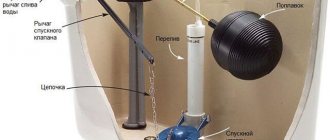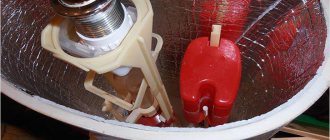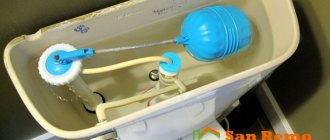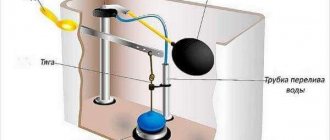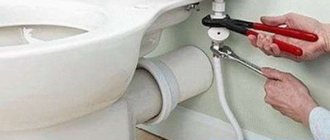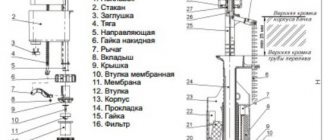Leaking water from the tank into the toilet can become a big problem because the flow of cold water increases greatly. This also leads to the appearance of limescale in the drain bowl. The drain tank has a simple design and repairing it will not be difficult, even for inexperienced users. Most of the materials installed inside are made of plastic, which greatly reduces their service life and leads to constant breakdowns. But how to fix a toilet in a short time if water is leaking?
Drain system device
The plumbing term for a drain mechanism is “shutoff valve.” Before you repair a structure with your own hands, you first need to have a complete understanding of its structure. There are different filling options: with a float, bulb, membrane, side or bottom filling valve, push-button, chain, rod chain mechanism. The whole system consists of two mechanisms, each of which has its own function:
- float;
- drain
In addition to the internal arrangement, toilets also differ in the material from which they are made. The structures are porcelain (the most expensive), ceramic, metal, coated with anti-corrosion enamel and polypropylene (plastic). According to the type of drainage through the toilet bowl - with a horizontal drain or a circular one.
Drain tank with a membrane on a chain and a lever in the locking system Source septik27.ru
In old cisterns, where the toilet does not hold water, the fittings are made of steel with a special rocker arm that bends to adjust the water level. From time to time, steel wire may become deformed due to regular water pressure. In this case, the wire has to be constantly bent to bring the water level in the tank to the desired level.
Modern parts of shut-off valves are already made of dense plastic or plastic. These are two thick strips connected to each other with a screw fastening. The float chamber is adjustable according to the vertical principle. The rod is inserted into the float groove at a special level. Then additional adjustments are made, and then the tank lid is installed in its place. A decorative hole nut is screwed on top of the cover, in the center of which there is a rod knob.
How to check the serviceability of the tank
Normally, the flushing process goes like this. When you press the drain key or button (in older models it may be a lever on a chain), the drain valve opens. Water flows under pressure into the bowl and cleans it. The flow of fluid is most often in one burst, short-term. But sometimes it can be longer.
After resetting, the valve closes automatically, less often after pressing the button again. In any case, after closing it there should be no leakage in the bowl. If this is not the case, you need to test the tank to ensure it is working properly. We list the signs indicating possible problems.
Signs of leakage
- Lime deposits or rust stains have appeared in the bowl near the drain.
- Periodically appearing or even constant murmur.
- Weak and prolonged flushing. It doesn't look like a strong salvo release.
- The toilet wall located closer to the tank is wet. Moisture appears even when the plumbing fixtures have not been used for a long time.
- Moisture on the tank and pipes.
Drops of condensate appearing on the equipment indicate that cold liquid is constantly circulating in the pipeline. Whereas with normally operating equipment this should not happen. If such signs appear, technicians recommend first cleaning the inside of the tank. Sometimes the cause is dirt accumulated in it.
To do this, close the shut-off valve, empty the container and remove the fittings from it. Thoroughly clean off silt deposits and limescale deposits and reassemble the device. If the problem persists, look for another solution.
Instagram master_trub_
- Plumbing equipment
Do-it-yourself toilet installation: useful instructions for different models
Types of faults
As soon as it has been noticed that the toilet tank does not hold water, you need to immediately pay attention to several areas and elements:
- Float position. It is necessary that the water does not accumulate higher than the float itself is placed. It should always be on top of the water.
- Float integrity. A perforated (with holes, holes) float already requires replacement.
- Serviceability or malfunction of the shut-off valve.
- Integrity of the drain mechanism.
- Breakage of shut-off valve elements.
You can check the serviceability of the valve by lifting the float up. Next, they look to see whether the water flow stops or not. If the leak continues, the water is turned off, and then the valve is pulled out and cleaned. To do this, take an unnecessary toothbrush. If cleaning the valve does not help, then it should be replaced with a new one. The drain mechanism also needs to be pulled out and cleaned.
The float should not be completely immersed in water, its position is above the water Source mrrestavrator.ru
Repairing and stopping leaks - how to fix and eliminate if water runs in the toilet
What to do if a malfunction is detected? First you need to inspect the float for any malfunctions. If the float lever is skewed, water will not linger in the tank (it will accumulate, overflow and immediately flow out). If distortions and leaks are detected, you should open the lid and simply adjust the lever: install it horizontally, 2.5 cm lower from the entrance of the pipe to the tank.
The float itself should be level and empty. There shouldn't be any water inside. If water is detected inside the float:
- Take it out and drain the water.
- Remove the hole through which water enters (heat the plastic or wrap the float in a plastic bag).
- Attach the float back and watch it (if water gets inside).
Such measures are temporary. At the first opportunity, you should buy and install a new float.
Repair and adjustment
If the toilet does not hold water due to the breakdown of any part of the shut-off valve, then it is more advisable to replace everything than to try to repair it. This is especially true for modern designs of flush tanks, inside of which plastic sets of inlet valve, water outlet/drain, internal shut-off valves and other mechanisms are installed.
Water can leak not only into the toilet bowl, but also under the tank, and then onto the floor. In this case, you will have to completely remove the entire tank, change the seal, clear the blockages, and then install the tank in place with new sealing rings. Immediately establishing a normal water column level is also an important detail. An incorrectly adjusted level may result in water spilling through the shut-off valve into the toilet.
The water level is adjusted by unscrewing the fastening screw located on the rocker arm. Then change the angle and tighten the screw again. To increase the level of the water column, the float lever is raised, to decrease it, it is lowered until an acute angle is formed. When adjusting, it is important to monitor the free position of the rocker arm - it should not rest against the reservoir lid. Otherwise, water will be constantly drawn into the tank and overflow through the locking mechanism is inevitable due to excessive water pressure.
The process of diagnosing a shut-off rod and membrane for water leaks Source pannhomeservices.com
Causes of water leakage in a small stream
Tank is faulty:
- Overflow. The water supply should stop at a certain time (when the float is raised 2.5 cm below the pipe), but there are a number of reasons why this does not happen: the gasket in the tap is deformed; the gasket is not pressed well; the pin is rusted or deteriorated; The valve inside the tank is cracked.
- The lever moved out of place and the toilet began to leak.
- A rusty steel bolt or a cracked plastic bolt.
- Hardening of the rubber of the pear (when the rod is raised, the pear also rises; if the rubber hardens, the pear does not take the desired shape and does not sit correctly in place).
- If the plumbing is new, then a leak is possible due to improper assembly.
- Malfunction in the cuff (water flows between the tank and the bowl).
- Weak fastening of bolts and nuts (connection of the tank to the toilet shelf).
Also read our article, which will tell you in detail how to clean rust. A malfunction of the drain bowl is a rare occurrence; the main reason for this can be attributed to improper fastening of the toilet to the floor or wall.
Leaking from under the tank
In this place, the toilet leaks either from under the gaskets on the tank mount, or on the gasket between the tank and the platform.
As in the previous case, it is necessary to replace outdated gaskets. Even if the leak has formed in one place, say on the cistern mount, it is advisable to change the rubber between the cistern and the toilet (after disassembly it will most likely leak).
Whatever problem you have with your toilet. It needs to be eliminated immediately! Water is no joke.
First, you should make sure that the non-stop flow of water is caused by improper operation of the valve. Algorithm of actions for this case:
- Turn off cold water.
- Empty the tank.
- Raise the locking lever as far as it will go.
Malfunctions with valve bulb or overflow
Let's now look at less common causes of water leaking in the toilet. The first is poor sealing between the rubber bulb and the drain hole.
Rubber bulb
To check it, you need to do the following::
- Turn off the water using the appropriate valve.
- Completely drain the remaining liquid from the tank.
- Try to lift the flap with your hand and then release it.
- If it does not fit exactly into the mounting hole, you will need to adjust its position.
It often happens that due to poor quality water, rust build-up or lime deposits also form here. The tightness is broken, the bulb ceases to fully perform its function, and water begins to constantly flow into the toilet. If all the parts are intact and in satisfactory condition, you can simply clean them thoroughly. If the integrity of the gasket on the mounting hole is damaged, it should be replaced.
Place where dirt sticks under the rubber bulb
You can also take the advice of one user and try to restore the gasket. The essence of the method is to soften it with boiling water. It is suitable if you cannot find a new element that is suitable in shape.
Important! Installing filters for water purification will help to significantly extend the service life of all the above elements. Don't neglect them. They are relatively inexpensive, but will bring enormous benefits.
Overflow
The last reason for water leaking in the toilet is a breakdown of the overflow itself. It is a plastic pipe extending from the bottom. If the tank is completely filled with water, this pipe protrudes slightly above its level. A crack may form on the overflow flask, which will allow water to leak into the drain hole of the tank. In this case, you will have to replace part of the reinforcement, since restoring the integrity of the part is extremely difficult.
Conclusions and useful video on the topic
The author talks in detail about the structure of the drain tank and shows with an example how to repair the shut-off and overflow valves. Also from the video you can learn about the causes of the breakdown and how to fix it:
The master shows how to eliminate a tank leak using improvised means. It is shown how to adjust the drain valve and install an additional part:
The author offers his own method of repairing a float. He shows in detail how to find out the cause of the leak and repair the fittings:
As you can see, there are no complex elements among the components of the tank. Therefore, if desired, everyone can handle the repairs. The main thing is not to rush and outline a preliminary work plan.
But if you are not confident in your abilities or were unable to fix the problem on your own, then you should contact a plumber.
Would you like to tell us how you corrected the situation with a tank that did not hold water with your own hands? Do you have information about technological subtleties that may be useful to site visitors? Please write comments in the block below, ask questions, post photos on the topic of the article.
>
The drain tank does not hold water: why does this happen and what to do?
Plumbing fixtures have become so commonplace in our apartments, houses, and office spaces that their presence is taken for granted.
But some fifty years ago, the majority of Russians did not even imagine that a “latrine” could be arranged inside a house or apartment - almost everywhere they used free-standing sheds installed above cesspools.
And today, problems with plumbing terrify ordinary people - after all, without a properly functioning toilet, the advantages of apartments are negated.
Leak prevention
To prevent leaks, carefully monitor the serviceability of the fittings and regularly perform preventive maintenance. Cleaning all parts of the fittings and the inner surface of the tank is the simplest and most important step. Careful observation shows how quickly the walls and bottom of the tank become covered with a rusty coating. Mineral deposits and mucus settle there. The rate of pollution is affected by water quality.
Additionally, periodically check the condition of the rubber seals, fasteners and parts located at the joints. This helps you notice a leak in time. Even slight moisture at the joints indicates a loss of tightness. In this case, tighten the bolts or change the gaskets.
How does a drain valve work?
The drain valve is a mechanism that keeps a mass of water inside the tank when it is not in use. It also releases liquid into the toilet bowl when flushing.
The drain valve design is based on the action of pressure and traction force.
When the tank is full, the water pressure allows the membrane or bulb covering the flush hole to be held in place, preventing leakage. When a lever or button is pressed, the mechanism is activated, opening the hole and allowing water to flow into the bowl.
The first signs of water leakage
Even an inexperienced person in plumbing can understand that the tank does not hold water, and therefore it flows into the toilet:
The process of collecting liquid into the tank does not stop, water constantly flows into the toilet and, if the sewage system is faulty, it can flood the bathroom;
Cold water consumption indicators on the meter scale increase significantly - this entails an increase in the total amount in the housing and communal services receipt;
The constant addition of water into the tank leads to the constant noise of flowing water;
